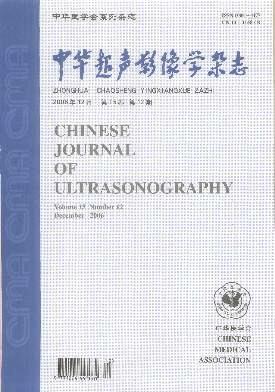Feasibility study of three-dimensional printing combined with mock circulatory system to make compliant mitral valve model for hemodynamic testing in vitro based on ultrasound image data
Q4 Medicine
引用次数: 0
Abstract
Objective To explore the feasibility of three-dimensional(3D) printing combined with mock circulatory system of flexible mitral valve model for hemodynamic testing in vitro based on ultrasound image data, making the transformation of 3D printing valve model from static to dynamic and from anatomical to functional, as well as assisting surgical plan for mitral valve diseases. Methods A total of 10 subjects underwent three-dimensional transesophageal echocardiography (3D-TEE) and proved to be without mitral diseases were collected as mitral normal group from February 2017 to December 2018 in Renmin Hospital of Wuhan University, 10 mitral stenosis patients were collected as mitral stenosis group, and 10 mitral regurgitation patients were collected as mitral regurgitation group. Hemodynamic parameters of velocity (peak E), pressure gradient were obtained by two-dimensional transthoracic echocardiography in three groups, and the degree of mitral valve stenosis and regurgitation were also evaluated. Then 3D-TEE was performed to obtain the 3D volume image of mitral valve. After image post-processing and 3D modeling, the valve mold was printed with soluble material polyvinyl alcohol (PVA). The mixture of human skin silicone, silicone oil, starch and curing agent were poured into the mitral valve mold in a certain proportion to make flexible silicone mitral valve model. Then, the compliant valve model was placed in mock circulatory system (MCS), regularly opening and closing as it in vivo in the heart cycle. The hemodynamic parameters of mitral valve were measured again in vitro and the degree of stenosis and regurgitation was also evaluated respectively. Paired t test was used for statistical analysis of in vivo and in vitro measurements in two groups, and the consistency test was performed. Results The mitral valve 3D-TEE images of all patients were successfully post-processed, mitral valve molds were printed and flexible models were made. In vitro hemodynamic tests were all completed. The opening and closing state of the valve model in vitro was similar to that in vivo. Mitral valve regurgitation was detected in mitral regurgitation group in vitro, with degree to that in vivo. There were no statistically significant differences in hemodynamic parameters measured in vivo and in vitro models (all P>0.05), with a high consistency (r=0.76). Among the 10 patients with mitral stenosis and 10 patients with mitral regurgitation, 18 patients were evaluated as same degree as in vivo. Conclusions 3D printing of compliant mitral valve model based on ultrasound image is feasible, which reproduced hemodynamic features of mitral valve in vitro, setting foundation for further surgery simulation and clinical decision-making. Key words: Three-dimensional printing; Mitral regurgitation; Mitral regurgitation; Hemodynamics; Mock circulation system基于超声图像数据的三维打印结合模拟循环系统制作二尖瓣体外血流动力学测试模型的可行性研究
目的探讨基于超声图像数据的柔性二尖瓣模型三维打印与模拟循环系统相结合进行体外血流动力学测试的可行性,实现三维打印瓣膜模型从静态到动态、从解剖到功能的转换,为二尖瓣疾病的手术计划提供辅助。方法收集2017年2月至2018年12月在武汉大学人民医院接受三维经食管超声心动图(3D-TEE)检查并证实无二尖瓣疾病的10例受试者作为二尖瓣正常组,10例二尖瓣狭窄患者作为二尖瓣狭窄组,收集10例二尖瓣返流患者作为二尖瓣返流组。通过二维经胸超声心动图获得三组患者的血流动力学参数(峰值E)、压力梯度,并评估二尖瓣狭窄和反流的程度。然后进行3D-TEE以获得二尖瓣的3D体积图像。在图像后处理和3D建模之后,用可溶性材料聚乙烯醇(PVA)印刷阀门模具。将人皮肤硅胶、硅油、淀粉和固化剂的混合物按一定比例倒入二尖瓣模具中,制成柔性硅胶二尖瓣模型。然后,将顺应性瓣膜模型放置在模拟循环系统(MCS)中,在心脏周期的体内有规律地打开和关闭。在体外再次测量二尖瓣血流动力学参数,并分别评估二尖瓣狭窄程度和反流程度。使用配对t检验对两组的体内和体外测量进行统计分析,并进行一致性检验。结果成功对所有患者的二尖瓣3D-TEE图像进行了后处理,打印了二尖瓣模具,制作了柔性模型。体外血液动力学测试全部完成。体外瓣膜模型的打开和关闭状态与体内相似。二尖瓣反流组在体外检测到二尖瓣反流,其程度与体内相当。在体内和体外模型中测量的血液动力学参数没有统计学显著差异(均P>0.05),具有高度一致性(r=0.76)。在10例二尖瓣狭窄患者和10例二尖瓣反流患者中,18例患者的评价与体内相同。结论基于超声图像的顺应性二尖瓣模型的三维打印是可行的,它再现了体外二尖瓣的血流动力学特征,为进一步的手术模拟和临床决策奠定了基础。关键词:三维打印;二尖瓣反流;二尖瓣反流;血液动力学;模拟循环系统
本文章由计算机程序翻译,如有差异,请以英文原文为准。
求助全文
约1分钟内获得全文
求助全文
来源期刊

中华超声影像学杂志
Medicine-Radiology, Nuclear Medicine and Imaging
CiteScore
0.80
自引率
0.00%
发文量
9126
期刊介绍:
 求助内容:
求助内容: 应助结果提醒方式:
应助结果提醒方式:


